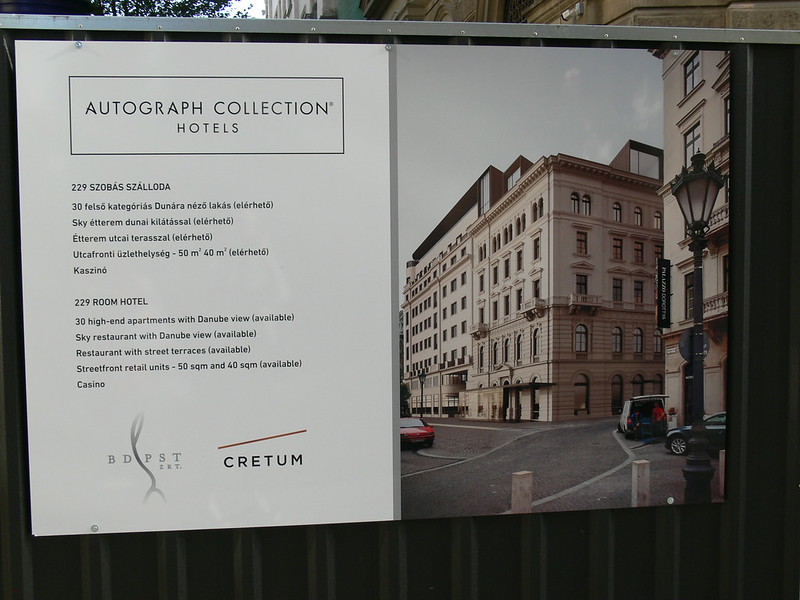The https://english.atlatszo.hu use cookies to track and profile customers such as action tags and pixel tracking on our website to assist our marketing. On our website we use technical, analytical, marketing and preference cookies. These are necessary for our site to work properly and to give us inforamation about how our site is used. See Cookies Policy
Budapest World Heritage Site endangered in hotel construction project by Orban’s son-in-law
Construction is underway in the UNESCO World Heritage Site of downtown Budapest, where a luxury hotel and condominium housing is being built by BDPST Zrt., a company with István Tiborcz, the Hungarian PM Viktor Orban’s son-in-law as its majority owner. Advocates for cultural heritage protection, including UNESCO, have long argued that this construction project endangers the World Heritage Site.

“If the MAHART House is dismantled with impunity, there is no stopping from now on, anything can be done with the built heritage” – said a source familiar with the Hungarian heritage protection system.
The United Nations Educational, Scientific and Cultural Organization (UNESCO) has also put a heavy emphasis on one of the buldings included in the hotel construction project, the MAHART House, which used to be the headquarters of the Hungarian shipping company.
The fate of the MAHART House was adressed in a monitoring report following UNESCO’s February 2019 visit to Budapest. The Hungarian government answered that “the World Heritage Center was provided false information on the former MAHART building”.
Atlatszo published an anonymous expert analysis which says there are mulitple problems with the MAHART House reconstruction project, such as the demolishing of the inside wings of the building, and the fact that only the facades were kept. The MAHART House is an individually protected monument: this means that by law all its components and accessories are protected and should be preserved in their original state.
UNESCO was not satisfied with the Hungarian government’s response either. In April 2019, they considered it necessary to carry out a more stringent review and they sent a reactive monitoring mission to Budapest. They produced a second report based on on-the-spot visits, meetings with government and NGO representatives.
UNESCO: Budapest might end up on the “World Heritage in Danger” blacklist
On 4 July, the UNESCO World Heritage Committee voted a strict decision concerning Hungary that requests the state to submit by 1 February 2020 an updated report on a list of issues found by the committee.
This document also repeatedly refers to the MAHART House, which is part of BDPST Zrt’s hotel construction project, in the following terms:
”The revised project for the MAHART building project, and the respective HIA, together with a professional building analysis, should be submitted to the World Heritage Centre for review prior to building permit being issued.
The MAHART building has been built by the Royal Shipping Company of Hungary in secession style in 1913. The building is located on the edge of an urban block overlooking the Danube banks. Whilst the lower floors were occupied by the owner’s offices, the upper floors were rented out as apartments.
The project for the deep restructuration includes the entire building block; its inner courtyard is to be covered with a glass-roof. The MAHART building is to become a hotel, partly residences. The project provides to maintain the facades, the entrance hall, the staircase and few walls, but to demolish the other parts of the inner and outer building such as floor structures, walls, façade to the courtyard and the roof. The latter is to be replaced in a traditional section (the former project with flat roofs has been abandoned). The street angle towards the Danube is occupied by a cupola containing a sky-bar.
The project is an example for the development of Budapest inner city. The outside appearance is maintained or (in the case of the cupola) re-proposed. However, the content of the house is changed, its urban scale is not one house anymore, but an entire urban block, and further, the staircase the inner building structure and the façade to the courtyard are demolished. The façade has become just a thin layer covering a modern building. Evidently, this kind of operation leads to an important threat to authenticity.
The Mission concluded, that the project is to be revised on the basis of a deepened analysis of the inner building structures and the existing interior finishing. The aim is to maintain the inner building structures and the backward façade. The Mission recommends that the building analysis and the revised project be submitted to the World Heritage Centre for comment.”
Unfortunately, however, this serious criticism came too late, as the government had ignored previous warnings about the building, and a few weeks before the April visit by UNESCO, the hotel construction project was granted permission.
We wanted to see exactly what is happening now with this protected building following the warnings by the international organisation. BDPST Zrt., the company now owning Mahart House and two other buildings involved in this project, did not allow us to look at the construction, wich already started, so we could only photograph the scene from the street.
The sight did not reassure us about the fate of the protected buildings.
Since the buidings involved in this hotel project are part of our cultural heritage, we thought it should be public information what happens to the houses protected both as listed monuments and as part of the world heritage site, during the construction of the hotel. We wanted to see how these buildings were being redeveloped, but we were not allowed to the construction site.
“Because of the construction site and the ongoing renovation work, unfortunately we are unable to provide access to the site due to, among other things, occupational safety regulations. We cannot provide insight into the building plans, they are only available to parties specified in the relevant legislation. In the case of private investments, the press does not fall into this category. In addition, due to the clauses contained in the BDPST Group agreements, the construction plans are considered as trade secrets.”
Instead of an on-site visit, we received a promotional document from the company that reads:
“The investment concerns a complex of buildings that is part of the capital’s architectural heritage, the preservation and protection of which is of paramount importance. During the investment, the development consortium will, in addition to carrying out certain restoration tasks, strictly adhere to the regulations which are the responsibility of the investor in the renovation of buildings under protection.”
They also claim not to demolish the inner parts of the buildings:
“The project reveals, protects and refurbishes not only the facades of buildings but also its interior architectural values. […] During the development, only subordinate parts of the building which do not represent a monument will be demolished.”
However, according to architectural heritage experts we consulted, this argument runs counter to the law, because if a building is a monument, not only certain parts of it, but the entire building is protected, and even its surroundings must be taken into account in construction projects.
Written and translated by Gabriella Horn
You can read the original, Hungarian language story here.



